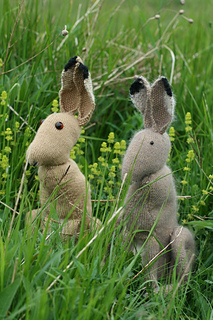patterns >  Jackie Jeffery's Ravelry Store
Jackie Jeffery's Ravelry Store
> Archibald Hare





Archibald Hare
This is a knitting pattern to make a lifelike hare with the gangly hind legs that produce the life-saving speed they possess. Knitted on straight needles, the seams help to give your hare structure. Using fine needles gives a dense fabric and delicate look to your hare.
Most of the work is in stocking stitch but there is a small amount of intarsia on the ears that are knitted in moss stitch to ensure they are dimensionally stable. There is a little more stranding or intarsia work in making the tail. The knitting and sewing skills required are not extensive but there are many increases and decreases in this pattern that require attention to detail, making the pattern unsuitable for beginners unless they are very patient.
This pattern may be knit in 4 ply or double knit yarns giving a height (excluding ears) of 28 or 30 cm respectively. Most parts of the hare are the same regardless of which yarn is used, but two sizes are given for the head and ears, depending on the weight of yarn used.
Materials
2 x 50 g brown 4 ply wool, eg Eden Cottage Milburn in Autumn Fields.
2 x 25 g Brown angora, mohair or alpaca silk eg Drops Brushed Alpaca Silk in Beige (05)
Or 3 x 50 g dk, eg Eden Cottage Milburn in Autumn Fields
1 x 50 g brown 4 ply wool (optional), eg Eden Cottage Milburn in Autumn Fields.
Plus for all versions
1 x 50 g ecru 4 ply wool, eg Eden Cottage Milburn in Natural
Small oddment black 4 ply wool
1 x 25 g white angora or alpaca silk eg Drops Brushed Alpaca Silk in Off-White (01)
1 x 25 g black angora or alpaca silk eg Drops Brushed Alpaca Silk in Black (16)
2.5 mm straight needles
waste wool/spare needle
stitch marker
polyester toy stuffing
eyes, either safety eyes or glass teddy bear eyes (optional).
weights, eg 2 curtain “pennies” or 5 x 2p coins in the UK. Enclose firmly, first in toy stuffing and then an offcut of fabric, the coins stacked one on top of the other.
26862 projects
stashed
18672 times
1479 projects
stashed
1384 times
395 projects
stashed
363 times
- First published: June 2018
- Page created: June 6, 2018
- Last updated: March 29, 2020 …
- visits in the last 24 hours
- visitors right now




